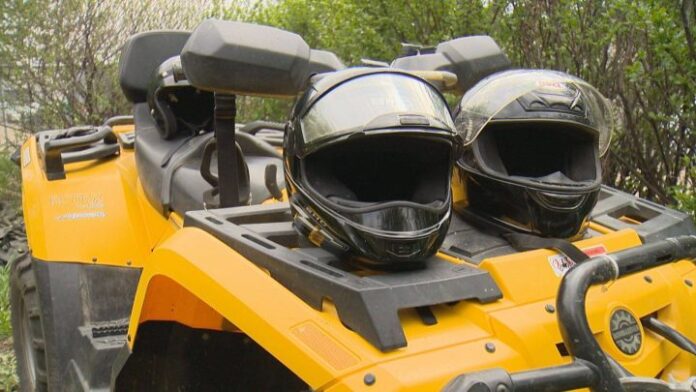A growing number of Maritime children were seriously hurt in all-terrain vehicle incidents last year. And as hospitals elsewhere in Canada report a similar wave, child safety advocates say it’s time for stricter rules for the off-road vehicles.
Physicians report that children injured in ATVs, or quads as they’re broadly known, are often badly hurt. Twenty per cent of cases they see involve head injuries, which can result in lifelong complications or death.
Although ATV injuries can happen at any age, data shows children are overrepresented. Children under 16 years of age account for nearly one quarter of ATV-related deaths in Canada, according to the Canadian Paediatric Society’s position statement on preventing injuries from all-terrain vehicles.
Injured children are often treated in the emergency department or, when their condition is more serious, they are admitted to pediatric intensive care units. In some cases, children do not even make it to the hospital and die from their injuries. Last year, IWK Health in Halifax, the major pediatric trauma centre in the Maritimes, saw increases in ATV-related ICU trauma admissions, rising to the highest level since it began tracking such admissions 31 years ago.
“This increase is just the tip of the iceberg,” said Chris Soder, a pediatric intensive care physician at IWK Health, which typically sees just one ATV intensive care case per year but had four in 2021.
Pediatric hospitals in Quebec and Ontario are seeing a similar pattern, according to hospital trauma directors.
In Montreal, there are more cases, injuries are more severe and they involve younger children, Debbie Friedman of the Montreal Children’s Hospital said in an email. She suggested COVID-19 restrictions on organized sport may have been a factor that led to children riding more often.
Her hospital’s number of ATV-injured patients nearly doubled from 16 in 2020 to 31 in 2021, according to data from the Canadian Hospitals Injury Reporting and Prevention Program. Last year’s numbers were well above the hospital’s average since 2000 of 23 ATV injuries per year.
Suzanne Beno, trauma director at Hospital for Sick Children in Toronto, said in an interview the hospital has seen similar increases in ATV-related admissions.
But quads are especially popular in Atlantic Canada and other rural areas. Manufacturers market youth-sized ATVs as being designed for smaller hands and limited to lower speeds.
Trending Stories
‘My dad’s a hero’: B.C. man fights off cougar to save daughter’s dog
A man bought an NFT for $2.9M, then listed it for $48M. The top bid was less than $280
These modifications, however, “don’t change the fact that children under 16 do not have the physical or cognitive maturity to safely operate such machines,” says Beno.
Wayne Daub of the Canadian Quad Council disagrees. In an interview, he said he is not aware of research on the relative safety of youth-sized ATVs, but he said that for those 12 years and older, they are safer than being on adult-sized ATVs, which are more difficult to steer and brake.
But ATVs are inherently less stable than automobiles. According to a report on deaths from the office of the chief medical examiner in Alberta, between 2009 and 2019, tipping and rollovers accounted for half of deaths from ATV incidents. The vehicles are not subject to the same rules about seatbelts, let alone car seats or boosters, which are known to improve passenger safety in automobiles.
The Atlantic provinces all have some form of ATV safety legislation. In Nova Scotia, for example, children aged six to 13 can use ATVs only on closed courses designed to provide a safe, controlled environment. There are, however, no such courses registered in the province.
And the reality is that most riders — adults or children — are in remote areas where enforcement of safety is difficult and supervision can be lacking. Beno says an adult should ride within 50 metres and maintain continuous, unobstructed vision of a child on an ATV.
Daub says it is possible for children to ride safely in remote areas. The emphasis should be on mandatory and frequently updated education and training and clearly defined adult supervision, as “this is where we fall short” in Canada, he says.
But safety features and training for ATVs “just doesn’t seem to be enough,” said Samantha Noseworthy of Child Safety Link, an injury prevention organization, who wants more awareness about the dangers ATVs pose to children.
Noseworthy, a health promotion specialist, said in an interview that ultimately legislative changes are needed to prevent more injuries and deaths among children, and that a minimum age of 16 years for ATV use for both drivers and passengers is needed.
Daub argues a “ban” is never the best solution and will only lead to children to use ATVs in unsafe areas, in order to avoid being caught.
More important in the meantime, he says is not the age but size of the child, and that parents taking a gradual approach to teaching children to ride.
Both sides agree that legislative changes on ATV use by children — whether to outlaw the practice or to require education and training — should be made a priority by provincial governments. Beno says it is essential that governments be informed of new evidence that is updated frequently and use real world advice to make the safest possible decisions on ATV use for children.
New study raises questions about whether safety regulations for children using ATVs are adequate – Jun 28, 2018
This report by The Canadian Press was first published April 17, 2022.
© 2022 The Canadian Press



